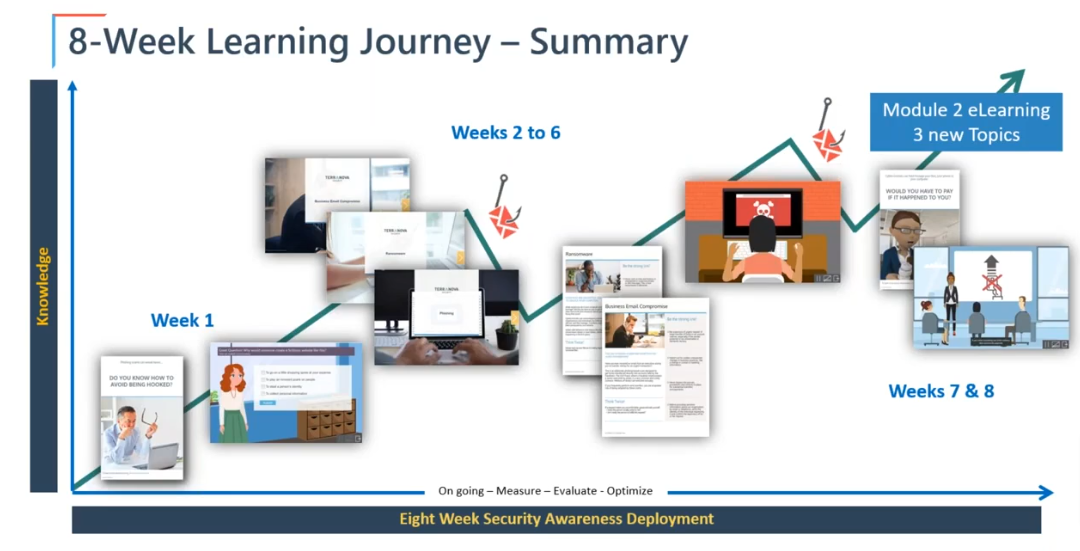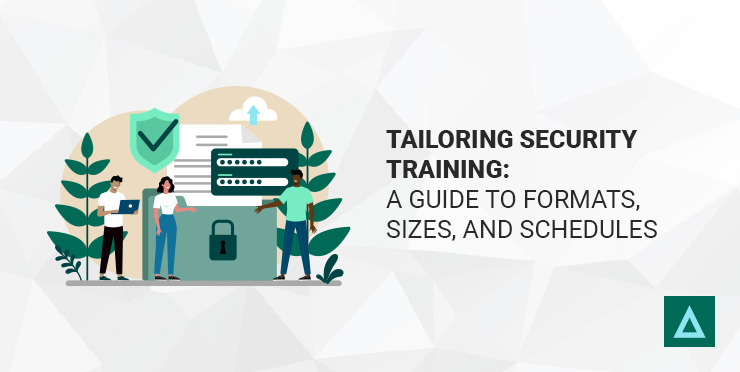As cybersecurity awareness training becomes a necessary addition for all companies worldwide, many organizations are wondering how best to integrate it into their workflows.
There is no one-size-fits-all schedule for cybersecurity training programs. The optimal way to deliver this kind of knowledge depends on your goals, the behaviors you are looking to modify, the size of your company, and how the training will be delivered.
A common issue in implementing an effective security awareness program is infrequent and lengthy training, which leads to poor engagement and low knowledge retention. This article explains the power of frequency, gamification, and interactivity in designing a cybersecurity awareness training program.
Importance of Security Awareness Training
When done correctly, cybersecurity awareness can be a rewarding experience for your employees and the best protection against certain cyber threats.
However, if the campaign isn’t carefully planned and customized to your specific needs, these trainings can become wrought with issues of all sorts.
Below are the three stages of any cybersecurity training campaign:
- Select topics: Focus on your main issues, considering what cyber threat would be most damaging to your business, such as preventing phishing, ransomware, and business email compromise.
- Advertise your campaign: Develop a cohesive mix of advertising methods, such as posters, email newsletters, and best practices documents.
- Optimize: Monitor the results throughout your campaign and adapt as you go.
The Role of Learning Size and Frequency
A common issue with cybersecurity awareness training is its inadequate length and frequency. As evidenced by a poll conducted live during a webinar hosted by Terranova Security, 60% of attendees believed this type of training should be done once a year.
Cyber threats evolve and change rapidly, exposing companies that believe in yearly training to perpetual risks. Additionally, infrequent training fails to build a strong enough foundation for employees to remember the content.
Training employees only once a year is like going to the gym only once a year. It’s not enough to make a difference.
Just as humans need regular exercise to stay healthy, employees need regular cybersecurity training to build and retain the necessary reflexes to defend against continuously evolving threats.
Shorter, more frequent training allows organizations to adapt based on employee test scores and keep users updated on new cyber threats.
The Eight-Week Learning Journey
The ideal way to deliver cybersecurity training is in short, focused bursts spread out over eight weeks. This method ensures that knowledge remains fresh in people’s minds.
When information can be recalled between lessons, it reinforces the links between safety habits and the threats they counter. This cycle can also be repeated throughout the year, as needed:
Week 1: Introduce topics using posters and teaser videos to remind people of the upcoming training and get them in the mindset.
Weeks 2-6: Core learning period with interactive e-learning modules.
Week 7: Reinforcement through microlearning and review; this is also the stage where you can review results from the modules and add additional microlearning instances to adjust.
Week 8: Conclusion with feedback, assessment, and next steps.
Getting Safe Cybersecurity Habits to Stick
While the model above is a generic breakdown that works for most companies, it is essential that you customize it to your needs and goals. Additionally, length is only one part of the equation. Frequency and timing of training play a potentially even bigger role.
Don’t limit your training to quizzes and classes. An excellent way to recall training material in a helpful and manageable way is to upload best practices documents for handling various cyber threats to the company intranet so employees can review them as needed.
Physical posters displayed around the office and laminated sheets with helpful tips can also be good ways to remind people about cybersecurity in their day-to-day lives.
Ensure your training is delivered across varied media types, such as videos, PDFs, and infographics. Training that incorporates real-world scenarios with interactive elements can engage users more effectively and provide helpful context for applying the learnings during their workday.
Including gamification elements like interactive quizzes and leaderboards can significantly increase engagement by making the learning process more enjoyable and competitive.

Tailoring your training program to your industry is crucial, as certain cyber threats are more prevalent in sectors like healthcare and finance. Reflecting the reality of your workforce in training scenarios and offering training in languages spoken in your company can enhance the effectiveness of your program.
The Right Training at the Right Time
The right length of training for your organization is deeply rooted in your specific challenges and issues. The general trend for any workplace training is that shorter is better.
Keeping things short and enjoyable is a great way to combat the dull perception of this type of training. Spreading out the training over a few weeks also allows you to adapt and change your content to maximize engagement as you see the data from your user’s completion rates.
Once there is engagement, the training becomes easier to deliver, and knowledge is integrated naturally and practically for everyone involved.
Watch the webinar here for in-depth insights and practical tips on designing and implementing effective security training programs.
